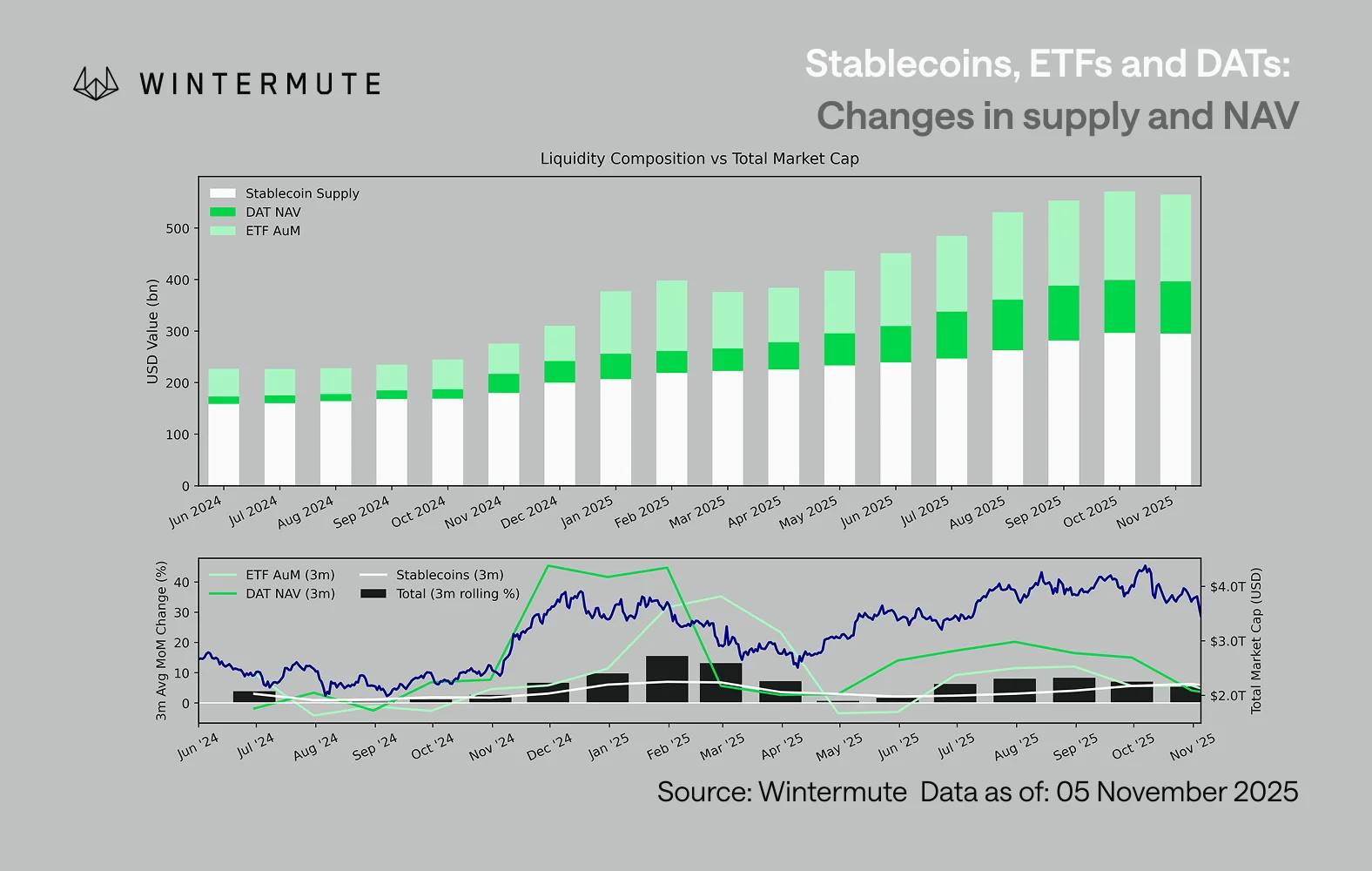Liquidity determines every cryptocurrency cycle.
Author: Jasper De Maere
Translated by: Shenchao TechFlow
Introduction
Liquidity drives cryptocurrency cycles, and the inflow of funds through stablecoins, ETFs, and DATs (Digital Asset Trusts) has noticeably slowed.
Global liquidity remains strong, but higher SOFR (Secured Overnight Financing Rate) has directed funds towards government bonds and away from the cryptocurrency market.
Cryptocurrencies are currently in a self-financing phase, with capital circulating internally, waiting for new inflows to return.
Liquidity determines every cryptocurrency cycle. While technological applications may be the core driving force of the cryptocurrency narrative in the long run, it is the flow of funds that truly drives price changes. In recent months, the momentum of fund inflows has weakened. In the three main channels through which capital enters the cryptocurrency ecosystem—stablecoins, ETFs, and Digital Asset Trusts (DATs)—the momentum of fund flows has diminished, placing cryptocurrencies in a self-financing phase rather than an expansion phase.
Although technological applications are important drivers, liquidity is the key that drives and defines every cryptocurrency cycle. This is not just about market depth; it is also about the availability of funds themselves. When global money supply expands or real interest rates decline, excess liquidity inevitably seeks risk assets, and historically, cryptocurrencies have been one of the biggest beneficiaries, especially during the 2021 cycle.
In past cycles, liquidity primarily entered the digital asset space through stablecoins, which serve as the core fiat entry point. As the industry matures, the three major liquidity channels have gradually become key determinants of new capital inflows into cryptocurrencies:
Digital Asset Trusts (DATs): Tokenized funds and yield structures that connect traditional assets with on-chain liquidity.
Stablecoins: On-chain representations of fiat liquidity that provide foundational collateral for leverage and trading activities.
ETFs: Access points in traditional finance that provide BTC and ETH exposure for passive investment and institutional capital.

By combining the asset management scale (AUM) of ETFs, the net asset value (NAV) of DATs, and the number of issued stablecoins, it is possible to reasonably estimate the total capital inflow into digital assets. The chart below shows the trend of these components over the past 18 months. The bottom of the chart clearly indicates that changes in total volume are closely related to the total market value of digital assets; when fund inflows accelerate, prices rise accordingly.
A key observation is that the momentum of fund inflows into DATs and ETFs has significantly slowed. Both performed strongly in Q4 2024 and Q1 2025, briefly rebounding in early summer, but this momentum has gradually weakened since then. Liquidity (M2 money supply) is no longer flowing into the cryptocurrency ecosystem as naturally as it did at the beginning of the year. From early 2024, the total scale of DATs and ETFs grew from about $40 billion to $270 billion, while the scale of stablecoins doubled from about $140 billion to approximately $290 billion. Although this shows strong structural growth, it also exhibits a clear stagnation in growth.
This slowdown is crucial because each channel reflects different sources of liquidity. Stablecoins reflect the risk appetite within the crypto industry, DATs capture institutional demand for yield, and ETFs reflect broader trends in traditional finance (TradFi) allocations. The simultaneous flattening of all three indicates an overall slowdown in the deployment of new capital, rather than just a rotation of funds between products. Liquidity has not disappeared; it is merely circulating internally within the system rather than expanding.
From a broader economic perspective outside of cryptocurrencies, liquidity (M2 money supply) is also not stagnant. Although higher SOFR rates have imposed some constraints on liquidity in the short term, making cash yields attractive and locking funds in government bonds, the world remains in a loosening cycle, and the U.S. quantitative tightening (QT) has officially ended. The overall structural backdrop remains supportive, but currently, liquidity has chosen other risk expressions, such as the stock market.

As external capital inflows decrease, market dynamics have become increasingly closed. Capital is rotating more between mainstream coins and altcoin sectors rather than new net inflows, creating a "player versus player" (PVP) situation. This also explains why market rebounds are short-lived and why market breadth has narrowed, even as total asset management scale (AUM) remains stable. The current peak in volatility is primarily driven by liquidation chain reactions rather than sustained trend formation.
Looking ahead, any significant recovery in a liquidity channel, such as the re-minting of stablecoins, the creation of new ETFs, or an increase in DAT issuance, would indicate that macro liquidity is flowing back into the digital asset space. Until then, cryptocurrencies remain in a self-financing phase, with capital circulating internally without achieving value expansion.
免责声明:本文章仅代表作者个人观点,不代表本平台的立场和观点。本文章仅供信息分享,不构成对任何人的任何投资建议。用户与作者之间的任何争议,与本平台无关。如网页中刊载的文章或图片涉及侵权,请提供相关的权利证明和身份证明发送邮件到support@aicoin.com,本平台相关工作人员将会进行核查。




